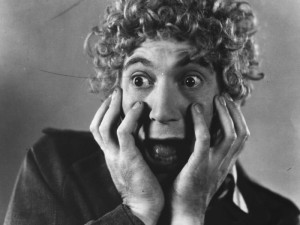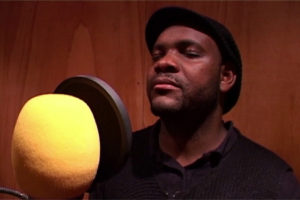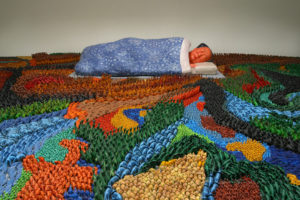The Lacanian Real
According to Lacan, the reality of everyday experience – or, what we might call, actuality – comes to be through the mediation of the symbolic and imaginary. He writes, “The world of words creates the world of things – things which at first run together in the hic et nunc of the all in the process of becoming – by giving its concrete being to their essence, and its ubiquity to what has always been” (Lacan, 2006; 228 – 229). Along with this sense of the real as actual, in his work of the 1950’s, Lacan elaborates a concept of, what he calls, wirklichkeit. Adopted from Freud, the German word translates into English as “reality,” but also carries the significance of “efficacy.” Lacan appeals to it in order to distinguish apparently immediately given empirical reality, from the “effects” in it of the unconscious: including hysterical symptoms, obsessional rituals, psychotic delusions, sexual fixation, etc. As definitive of all these phenomena, wirklichkeit thus designates what Freud affirms, as a cornerstone in the development of psychoanalysis, as psychical reality. Insofar as Lacan conceives the unconscious in terms of the structures and dynamics of the symbolic and imaginary that mediate experience, wirklichkeit is the reality of fantasy as more real than the actual: what Lacan also calls, the real-of-the-symbolic. Along with these two sense of reality, in the 1950’s, Lacan also defines the real as the hypothetical “primordial stoff,” that exists as a noumenal substrate, before and beyond the mediation of the symbolic. At times, he complicates this account by qualifying this hypothetical substrate of experience as material and equating it with the brute physicality of the body, without thereby clarifying his categories from those of biology. However, Lacan more often emphasizes the distance of this primordial stoff from experience, precisely to maintain the gap instituted in experience by the sundering of the signifier and to refuse the reduction of desire to instinctual nature. When he first formulates his theory of the three registers, Lacan accordingly defines the real essentially as that which “resists symbolization” (Lacan, 1988; 66). And, insofar as he treats it at all, he does so indirectly in opposition to his accounts of the imaginary and symbolic.
Whereas the real thus occupied a marginal position in the original formulation of Lacan’s theory of the three registers, beginning in his 1957 – 1958 Seminar VII: The Ethics of Psychoanalysis, Lacan contends that the subject has an originary relationship to the Real, whose resistance to symbolization manifests itself as a disruptive excess in experience. He writes,
[The subject] finds itself in the beginning led toward a first outside – an outside which, Freud tells us, has nothing to do with that reality in which the subject will subsequently have to locate the Qualitätzeichen, signs that tell him that he is on the right track in his search for satisfaction. That is, something which, even prior to the test of this search, sets up its end, goal, and aim. (Lacan, 1992; 52)From the outset of his teaching, Lacan describes the infant as confronted by an alien Other, which founds it as a subject and defines the fundamental parameters of its relationship to the world. Whereas initially he conceives this Other on the basis of the imaginary confrontation with the mirror, and subsequently explains it in terms of the subject’s inscription in language, now, however, he understands it firstly as real, in terms of what he calls, das Ding: the Thing. “The whole progress of the subject,” he continues, “is… oriented around the Ding as Fremde, strange, even hostile on occasion, or in any case the first outside.” (Lacan, 1992; 52)
Lacan discerns an echo of this original encounter in the horrified gasp, “You!” Rhetorically, he asks, “What does the emission, the articulation, the sudden emergence from out of our voice of that ‘You!’ (Toi!) mean? A ‘You’ that may appear on our lips at a moment of utter helplessness, distress or surprise in the presence of something that I will not right off call death, but that is certainly for us an especially privileged other – one around which our principle concerns gravitate, and which for all that still manages to embarrass us.” (Lacan, 1992; 56) Even prior to the existential reflection, registered in the hysteric protest “What do you want from me?” this “You!” registers the subject’s encounter with the Other as terrifying in its sublimity. Reflecting on the answer given, in deference to this Other, Lacan continues, “What is this ‘Me!’, this ‘Me!’ all by itself, if not a ‘Me!’ of apology, a ‘Me!’ or refusal, a ‘Me!’ that’s simply not for me? Thus from the beginning the ‘I’ as thrust forth in an antagonistic movement, the ‘I’ as defense, the ‘I’ as primarily and above all an ‘I’ that refuses and denounces rather than announces, the ‘I’ in the isolated experience of its sudden emergence – which is also perhaps to be considered as its original decline – this ‘I’ is articulated here” (Lacan, 1992; 56). Without thereby reverting to the imaginary rivalry of the mirror-stage, Lacan thus reformulates his concept of the originary, symbolic sundering of the subject as riddled with a strife that is irreducible to the critical reflection engendered by the constitutive absence of the signifier.
Doing so, Lacan does not, however, renounce his concept of language’s role in the genesis and structure of subjectivity, or otherwise assert the Real as immediately evident. While he postulates the subject’s relationship to the Real in the Other as “there from the beginning,” as evident in the approach he takes to it through this astonished “You!” Lacan nevertheless argues that the Real only ever appears as a disturbance in the symbolic order. “The Thing,” he writes, “only presents itself to the extent that it becomes word” (Lacan, 1992; 55). However, it does so paradigmatically in the lacuna of a silence. While Freud contends that the infant’s cry first registers the encounter with the Other, Lacan emphasizes the extra-linguistic dimension of this cry by arguing that, “the things in question are things insofar as they are dumb” (Lacan, 1992; 55). As exemplary of this muteness of the Thing, Lacan appeals specifically to the menacing mute, Harpo Marx. He writes,
Is there anything that poses a question which is more present, more pressing, more absorbing, more disruptive, more nauseating, more calculated to thrust everything that takes place before us into the abyss or void than the face of this Marx, that face with its smile leaves us unclear as to whether it signifies the most extreme perversity or complete simplicity (Lacan, 1992; 55).
In his appeal to the Harpo’s silence, Lacan reiterates the central importance of absence in the subject’s relationship to language. However, as opposed to his earlier theory, he conceives this absence as distinct from the constitutive division of the signifier.
While Harpo’s silence depends on the word, insofar as it only appears as a disturbance in the field help open by linguistic exchange, it is not therefore equivalent to the absence of the symbolic, which institutes the subject’s alienation from any immediately given experience and sustains the differential association between words. Instead, Harpo’s reticence interrupts the symbolic from a point in language that is irreducible to language, as an idiotic ecstasy, which manifests the Real as a disturbing incoherence in the symbolic.
According to Lacan, the real Thing does not therefore exist as immediately given, either in actuality or as a primoridial stoff beyond the limits of experience. To the contrary, he contends, “the Thing is not nothing, but literally is not. It is characterized by its absence, its strangeness” (Lacan, 1992; 63). Alienation from the Real is a condition of the actual, which must be positied in order to account for the jouissance of neurotic suffering and the divisions it reveals in (or rather, as) the subject: the Real only appears – in fact, it only exists – in the interruption of an absence. Its reality lies only in the material recalcitrance of the gaps and inconsistencies that it generates. Zizek writes, “For Lacan, the real at its most radical has to be totally de-substantialized. It is not an external thing that resists being caught in the symbolic network, but the fissure within the symbolic network itself” (Zizek, 2006; 72).
In his exposition of the decisive changes in Lacan’s thinking during the late 1950’s and early 1960’s, Lorenzo Chiesa accordingly argues that Lacan’s concept of the Thing marks something of an intermediary position in his renunciation of the transcendental horizon previously guaranteed by the Name-of-the-Father (Chiesa, 2007; 104 – 140). Having relinquished this transcendental signifier, Lacan now conceives the symbolic economy of the unconscious as corrupted by the Real that previously he supposed to lie outside its boundaries. However, in so far as the concept of the Thing implies the existence a noumenal substrate, beyond the limits of the symbolic, Chiesa argues that it betrays the persistence of the transcendentalist distinction between inside and out in Lacan’s conceptual logic. Accordingly, Chiesa contends that Lacan’s subsequent relinquishing of the concept of the Thing marks an advance in his thinking, through which he comes to conceive the Real instead, as an aspect of the object (a), which exists as “the remainder of the loss of an always already lost unity… of something which ultimately never existed” (Chiesa, 2007; 122).
When Lacan first introduces his concept of the object (a), he defines it as imaginary: the object of desire, correlative to the lack instituted by symbolic castration (-p). In his ultimate elaboration of the concept, which he claimed was his principal contribution to psychoanalytic critical theory, Lacan explains the object (a) as retaining these imaginary and symbolic functions, as the intersection of the three registers in the genesis and structure of the subject. However, when first defining it as Real, Lacan takes pains to distinguish the object (a) from both the imaginary object of desire and the lack engendered by symbolic castration. With reference specifically to both object-relations theory and phenomenology, Lacan defines the object of desire as the object of subjective intentionality: what Husserl calls the “noema,” which knowledge is always necessarily about. Whereas the object of desire lies “out in front,” Lacan argues that the object (a) lies “behind desire” (Lacan, Sem. X; 16.1.63). Rather than the referent of the subject’s intention, the exteriority of the object (a) precedes and conditions the very distinction between inside and outside, integral to the subject’s emergence. Instead of the object of desire, Lacan thus defines the object (a) as the object cause of desire. He writes, “What has to be introduced here to resolve this impasse, this riddle, is the notion of an outside before a certain interiorisation, of the outside which is situated here, (a), before the subject at the locus of the Other, grasps himself… in this specular form, which introduces for him the distinction between me and not-me” (Lacan, Sem. X; 16.1.63).
While Lacan ultimately explains it as an algebraic matheme, without analogy in experience, the letter “a” in his concept of the object (a) derives originally from the French word autre. Lacan first uses it as a formulaic term when schematizing his four-fold theory of the unconscious as another scene, specifically to denote the particular, imaginary, other identified with the ego, in the inter-subjective context established by a prior identification with an intra-subjective symbolic Other (A). In its specifically specular manifestation, which he subsequently distinguishes as i(a), the “a” thus formalizes the gestalt of the mirror-image as situated in the absence engendered by the sundering of the signifier. However, now, in keeping with his critique of, what he called, “the stage of history” in Levi-Strauss’ structural anthropology, Lacan now conceives this staging of the unconscious in fantasy as interrupted by the real, from which it simultaneously alienates the subject. To do so, he returns to the scene of the infant held before the mirror in the arms of its (m)Other. In the context of a conversation of the experience of depersonalization in psychosis, he argues that the “non-recognition of the specular image,” attests to the fact that “what is seen in the mirror is [so] anxiety-provoking [it] cannot be proposed to the recognition of the Other.” He continues,
The infant is not able to turn his head, in accordance with this movement which I described to you as familiar toward this Other, this witness, this adult who is there behind him, to communicate his smile to her, the manifestation of his jubilation about something which makes him communicate with the specular image, that another relationship is established of which he is too captive for this movement to be possible; here the purely dual relationship dispossesses.. the subject of this relationship to the big Other (Lacan, Sem. X; 23.1.63).
Having previously subordinated the imaginary confrontation with the mirror-stage to the subject’s inscription in the symbolic order, Lacan thus reasserts the primacy of this encounter as irreducible to – even an impasse in – the subject’s relationship to the symbolic, on the basis of the real in the imaginary.
In this regard, while the real as object (a) only exists as a remainder in the symbolic, contrary to the all too common account, it is not therefore the remainder of the symbolic. To make the point, Lacan postulates a cut in the real that is logically prior to and different from the cut of symbolic castration. Emphasizing the distinction, he contrasts this cut to the infant’s subsequent separation from its mother in weaning, by comparing it instead to separation from the enveloping placenta that sustained it in utero. “The cut involved,” he contends, “is not that between the child and the mother” (Lacan, Sem. X; 23.1.63). This later division registers the intervention of the father, insofar as he qualifies the mother’s coming and going as originarily symbolic. However, when separating from the placenta, the infant undergoes a division from itself, or rather from its immersion in the formlessness of organic life, which precedes and conditions this symbolic sundering. Lacan writes, “In order to have a complete notion of this pre-specular totality which is [the object (a)], you have to consider these envelopes as elements of the body” (Lacan, Sem. X; 23.1.63). While the placenta is conjoined to the mother, Lacan emphasizes its intermediary status as a parasite that does not in fact belong to her body. The Oedipal conflicts integral to the subject’s symbolic inscription are thus mapped onto the infantile organism, as marked by this prior division in the Real. Insofar as they intersect with the organism at the breast rather than the placenta, they do not therefore directly sublate the division of the subject in the Real. Instead, the sundering of the symbolic remains eccentric to this logically prior separation, powerless to redeem the loss it institutes, and so subject to its relentless disturbance: as both an integral condition of the symbolic, and yet in excess of its defining distinctions. As Real, the lost object in the genesis of subjectivity is thus not only categorically lost, its also is never entirely lost: stuck to one’s heal with the nagging insistence of a compulsion.
These reflections were included in Apropos of Nothing: Deconstruction, Psychoanalysis, and the Coen Brothers (SUNY, U.P.). They can be cited here as: Buckner, Clark. “The Lacanian Real” Resonator. Web. Day, Month, Year article as accessed.




